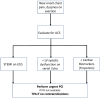Management of Takotsubo Syndrome: A Comprehensive Review
- PMID: 32042529
- PMCID: PMC6996473
- DOI: 10.7759/cureus.6556
Management of Takotsubo Syndrome: A Comprehensive Review
Abstract
Takotsubo syndrome (TTS), also known as Takotsubo cardiomyopathy, is a transient left ventricular wall dysfunction that is often triggered by physical or emotional stressors. Although TTS is a rare disease with a prevalence of only 0.5% to 0.9% in the general population, it is often misdiagnosed as acute coronary syndrome. A diagnosis of TTS can be made using Mayo diagnostic criteria. The initial management of TTS includes dual antiplatelet therapy, anticoagulants, beta-blockers, angiotensin-converting enzyme inhibitors or aldosterone receptor blockers, and statins. Treatment is usually provided for up to three months and has a good safety profile. For TTS with complications such as cardiogenic shock, management depends on left ventricular outflow tract obstruction (LVOTO). In patients without LVOTO, inotropic agents can be used to maintain pressure, while inotropic agents are contraindicated in patients with LVOTO. In TTS with thromboembolism, heparin should be started, and patients should be bridged to warfarin for up to three months to prevent systemic emboli. Our comprehensive review discussed the management in detail, derived from the most recent literature from observational studies, systematic review, and meta-analyses.
Keywords: acute coronary syndrome; cardiomyopathy; left ventricular outflow tract obstruction; takotsubo cardiomyopathy; takotsubo syndrome.
Copyright © 2020, Sattar et al.
Conflict of interest statement
The authors have declared that no competing interests exist.
Figures


References
-
- Is Takotsubo syndrome a microvascular acute coronary syndrome? Towards of a new definition. Lüscher TF, Templin C. Eur Heart J. 2016;37:2816–2820. - PubMed
-
- Prevalence of Takotsubo cardiomyopathy in the United States. Deshmukh A, Kumar G, Pant S, Rihal C, Murugiah K, Mehta JL. Am Heart J. 2012;164:66–71. - PubMed
-
- Typical Takotsubo cardiomyopathy in suspected ST elevation myocardial infarction patients admitted for primary percutaneous coronary intervention. Showkathali R, Patel H, Ramoutar A, et al. Eur J Intern Med. 2014;25:132–136. - PubMed
-
- Incidence and angiographic characteristics of patients with apical ballooning syndrome (Takotsubo/stress cardiomyopathy) in the HORIZONS-AMI trial. Prasad A, Dangas G, Srinivasan M, Yu J, Gersh BJ, Mehran R, Stone GW. Catheter Cardiovasc Interv. 2014;83:343–348. - PubMed
-
- Clinical features and outcomes of Takotsubo (stress) cardiomyopathy. Templin C, Ghadri JR, Diekmann J, et al. N Engl J Med. 2015;373:929–938. - PubMed
Publication types
LinkOut - more resources
Full Text Sources
